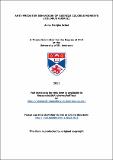Anti-predator behaviour of Guereza colobus monkeys (Colobus guereza)
Abstract
Black-and-white colobus monkeys are renowned for their impressive vocal behaviour, but up to date there have been only very few systematic efforts to study this. These monkeys are able to produce loud and low-pitched roars that transmit over long distances, which has lead to the assumption that these calls function in inter-group spacing and male-male competition. The fact that the monkeys sometimes produce the same calls to predators as well, has not received much attention so far.
This thesis presents a detailed description of the form and function of the anti-predator behaviour of one species of black-and-white colobus monkeys, the Guereza (Colobus guereza), with a specific focus on their alarm calling behaviour. A second aim was to determine the effects of predator experience on their anti-predator behaviour, with a specific focus on call comprehension and production. Data were collected from two populations of Guereza monkeys in the Budongo Forest Reserve, Uganda, that differ in predation pressures experienced by their main predators: leopards, eagles and chimpanzees. Results showed that Guerezas use a basic form of zoo-syntax in order to compose predator-specific call sequences that vary in the number of roaring phrases and snorts. These sequences are meaningful to recipients, at least at the level of the predator class, but there were also indications for additional levels of encoded information: Guerezas appear to have evolved a second system, based on acoustic variants of individual phrases, which allows them to narrow down the information content of call sequences, generating the potential to communicate highly specific information by using a mix of syntactic and semantic cues.
The monkeys’ vocal behaviour was influenced by predator experience, but not strongly so. Monkeys without prior experience with leopards lacked some of the behavioural nuances seen in leopard-experienced monkeys, but they nevertheless responded appropriately to visual and acoustic leopard models, suggesting they had retained the basic capacities to recognise this predator type as relevant and dangerous.
Results are discussed in light of the comparative approach to the study of human language evolution. Although human language is unique in a number of ways, for example through its use of complex syntax and intentional semantics, some animal communication systems have revealed similar features, and Guerezas, the first member of the colobine family to be studied in this respect, are no exception. The Guerezas’ alarm calling behaviour is complex and flexible, and these monkeys have provided another piece of empirical evidence that is directly relevant for the comparative approach to human language evolution.
Type
Thesis, PhD Doctor of Philosophy
Collections
Items in the St Andrews Research Repository are protected by copyright, with all rights reserved, unless otherwise indicated.

